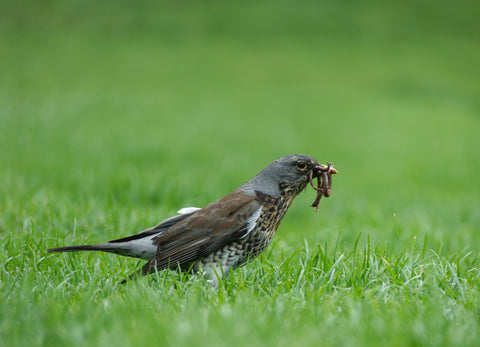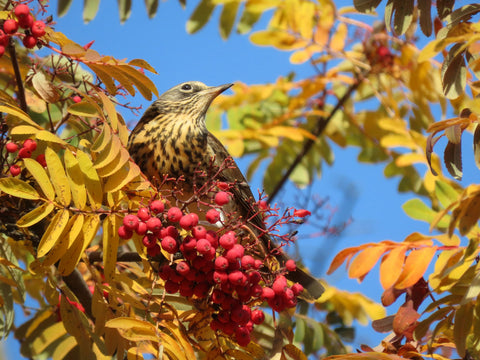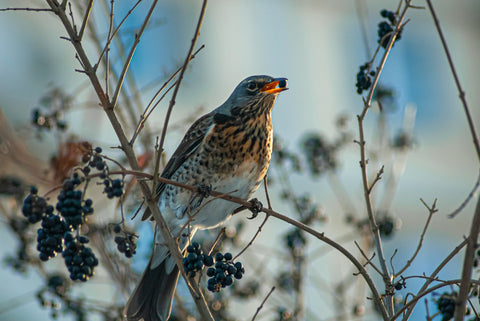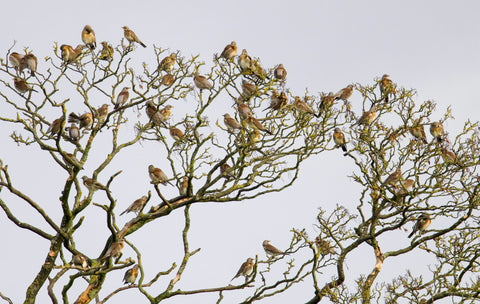One of our newest bird ornaments is the Fieldfare. I knew nothing about this bird so I went to do research and find more about it. Honestly, if you haven't heard of this feathered wonder, get ready to be amazed!
Who is the Fieldfare?

Imagine strolling through a picturesque countryside, surrounded by the gentle rustle of leaves and the distant melody of birdsong. Suddenly, a sleek, slate-gray body adorned with a speckling of warm, rusty hues, topped off with a striking black tail. That's our star of the day, the fieldfare (Turdus pilaris)." - Renowned ornithologist, Dr. Emily Smith
Appearance:

The fieldfare (Turdus pilaris) cuts a striking figure with its sleek, slate-gray plumage. But what truly sets it apart are the subtle accents of warm, rusty hues that adorn its breast and flanks, reminiscent of the autumn leaves it so often frolics among. And let's not forget that dramatic black tail, a bold statement against the muted palette of its body. Together, these elements create a visual masterpiece that's impossible to ignore.
Behavior:
Now, let's talk about personality because boy, does the fieldfare have character! Picture a bird that's equal parts graceful and mischievous, with a hint of sass thrown in for good measure. These avian acrobats are known for their playful antics, whether it's performing aerial acrobatics or engaging in spirited debates with their fellow flock members. They're not just birds; they're performers, delighting audiences with their charming demeanor and infectious energy.
Habitat:
Where does the fieldfare call home? Well, if you're lucky enough to reside in Northern Europe or Asia, chances are you've crossed paths with these delightful creatures. From lush woodlands to windswept moors, they're right at home in a variety of habitats, adapting effortlessly to their ever-changing surroundings. But don't let their cosmopolitan lifestyle fool you; at heart, they're true creatures of the wild, thriving in the untamed beauty of nature.
Symbolism:
In many cultures, birds are more than just winged creatures; they're symbols of freedom, resilience, and hope. And the fieldfare is no exception. With its boundless energy and indomitable spirit, it serves as a reminder that no matter how far we wander, there's always a place to call home. So next time you spot a fieldfare soaring through the skies, take a moment to reflect on the profound wisdom of these feathered philosophers.
The adventurous traveler
Now, what sets the fieldfare apart from your average garden bird? Well, strap in, because these feathery explorers are true globetrotters! Hailing from the chilly climes of Northern Europe and Asia, they're not your homebody robins. Nope, these guys are all about the thrill of migration. Come autumn, they bid farewell to their summer homes and embark on an epic journey to warmer lands.

- Migration Masters: Did you know that fieldfares are renowned for their impressive migratory journeys? According to recent studies by the British Trust for Ornithology, fieldfares can travel thousands of kilometers each year! Making them some of the most prolific migratory birds in the avian world.
- Winter Wanderers: During the colder months, fieldfares seek refuge in milder climates, often venturing as far south as Spain and North Africa. It's a testament to their resilience and adaptability in the face of changing seasons.
- Community Connections: But here's where it gets even more fascinating: fieldfares don't embark on these journeys alone. Oh no, they travel in large flocks, numbering in the thousands! Creating a mesmerising spectacle as they traverse the skies!
- Navigation Navigators: And just how do they navigate these vast distances? Well, it turns out fieldfares are equipped with an impressive internal GPS system. Recent research from the Max Planck Institute for Ornithology suggests that these birds rely on a combination of celestial cues, Earth's magnetic field, and even landmarks to guide their way.
Dining in style
Okay, let's talk about food because who doesn't love a good meal, right? The fieldfare isn't your average picky eater. Nope, they're culinary connoisseurs, relishing everything from juicy berries to plump insects. But here's where it gets interesting: they've got a sweet tooth for fermented fruits. Yep, you heard that right. These birds aren't afraid to indulge in nature's version of fine wine. Talk about living life on the edge!
The Fieldfare's Social Scene

Now, let's spill the tea on the fieldfare's social life. These birds are all about the squad goals. Picture them swooping through the skies in a tight-knit flock, chattering away like a group of old friends catching up over brunch. They're not just birds; they're a community, supporting each other through thick and thin. Plus, they've got killer harmonies. Move over, boy bands; the fieldfare choir is where it's at!
The call of the wild

Last but not least, let's talk about their vocal prowess. The fieldfare isn't shy when it comes to serenading the world with its melodious tunes. From cheerful chirps to flute-like whistles, their repertoire knows no bounds. So next time you're out for a stroll in nature, keep your ears peeled for the enchanting symphony of the fieldfare.
In Conclusion
The fieldfare, nature's feathered wanderer, never ceases to amaze with its adventurous spirit, eclectic palate, and vibrant social life. So next time you spot one of these charismatic birds gracing the skies, take a moment to appreciate the magic of the avian world. Until next time, happy birdwatching!
Hope you enjoyed the whimsical exploration of the marvelous fieldfare! Or if you wish to know the other birds we sell vist our bird ornaments.






















